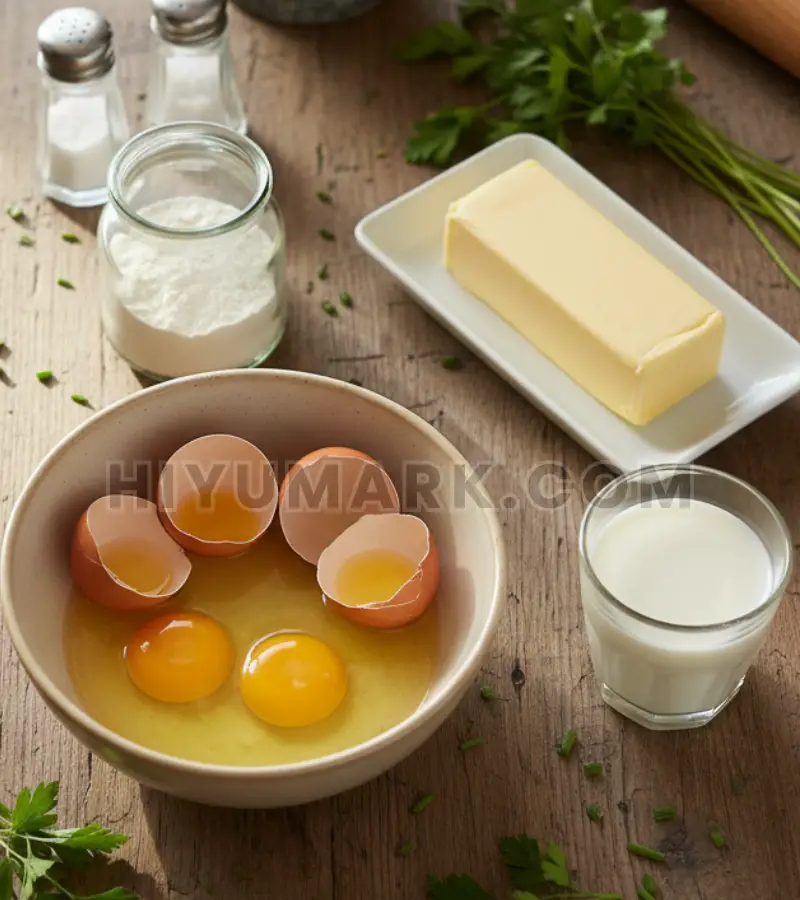This Amish scrambled eggs recipe makes soft, creamy, and filling eggs that feel simple yet comforting. Some Amish and Mennonite families even add flour with milk to stretch the eggs for larger gatherings, creating a dish that’s rich but practical.
Soft, creamy scrambled eggs that actually fill you up – that’s the promise of the Amish way. With just eggs, milk, butter, and sometimes a spoonful of flour, this dish stretches simple ingredients into something hearty and comforting.

It’s not just breakfast, it’s a tradition. Amish and Mennonite families have been making these eggs for generations, cooking them low and slow so every bite feels rich but never heavy.
The best part? You don’t need fancy skills or equipment. Just a skillet, a few pantry staples, and fifteen minutes. The result is scrambled eggs that taste like home.
What Are Amish Scrambled Eggs?
At first glance, Amish scrambled eggs may look like the same dish you’d make on a weekday morning. But there’s a key difference: many traditional recipes, especially the Mennonite style known as Ruhrei, whisk flour and milk into the eggs.
This stretches a small number of eggs into a meal large enough to feed a family while giving the dish a distinct creaminess.
Unlike standard scrambled eggs, these are made with farm-fresh eggs, plenty of butter, and often cooked low and slow. The result is soft curds that are hearty but never rubbery.
It’s a practical recipe born from Amish and Mennonite kitchens, where resourcefulness and simplicity define meals.
For some families, the recipe stays plain – just eggs, flour, milk, and butter. Others like to fold in onions, herbs, or even a sprinkle of cheese for extra flavor.
Gathering the Ingredients (and Their Roles)
Every ingredient in the Amish scrambled eggs recipe serves a purpose. Here’s a breakdown of what you’ll need and why it matters.

Eggs
The base of the recipe. Fresh eggs give the best flavor and structure.
Flour
Used in the traditional Ruhrei version. It stretches the eggs to serve more people and makes the texture creamier. Some cooks skip it, while others see it as essential.
Milk or Cream
Adds moisture and richness. When whisked with flour, milk helps create a silky consistency. Cream makes the eggs heavier and more decadent.
Butter or Cooking Fat
Butter brings flavor and keeps the eggs from sticking. In Amish kitchens, lard or bacon drippings are sometimes used for a smokier taste.
Seasonings
Salt and black pepper are the basics. Some cooks also add fresh herbs or a touch of onion for more depth.
Optional Add-Ins
Cheese, sautéed onions, or herbs like parsley can be mixed in for variety. These additions aren’t traditional but are common in modern variations.
Equipment: A mixing bowl, whisk, skillet, and spatula. A cast-iron pan is often preferred for its even heat.
Cooking Amish Scrambled Eggs Step by Step
Making the Amish scrambled eggs recipe is simple, but the method is what gives the dish its creamy texture and homestyle flavor.

Step 1: Whisk the Eggs
Crack fresh eggs into a mixing bowl. Whisk until yolks and whites are blended. For the Mennonite Ruhrei version, whisk in a spoonful of flour with the eggs.
Step 2: Add Milk or Cream
Pour in milk or cream and whisk again. If using flour, make sure no lumps remain. This step adds lightness and makes the scrambled eggs more filling.
Step 3: Prepare the Pan
Heat a skillet over medium-low heat. Melt butter until it foams but doesn’t brown. A well-heated pan coated with butter prevents sticking.
Step 4: Cook the Eggs Slowly
Pour the egg mixture into the pan and let it rest a few seconds. Stir gently with a spatula, folding from the edges to the center. This helps form soft curds instead of tiny scrambled bits.
Step 5: Finish and Serve
Remove the pan from heat when the eggs are mostly set but still glossy. Residual heat will finish cooking them. Season with salt, pepper, or herbs. Serve immediately with bread or breakfast sides.
Tip: Cooking low and slow keeps the eggs creamy. Rushing over high heat makes them rubbery.
Recipe Twists and Easy Substitutions
Amish scrambled eggs may be simple, but they’re also flexible. Families often adjust the recipe depending on what’s in the pantry or how many people they need to feed.
Plain and Traditional
The classic version uses just eggs, milk, and a touch of flour. It’s hearty and filling without any extras, making it true to Amish and Mennonite roots.
With Onions or Herbs
Diced onions sautéed in butter before adding the eggs give a deeper flavor. Fresh herbs like parsley or chives can brighten the dish and make it feel lighter.
Cheesy Variation
A handful of shredded cheddar or Swiss folded in at the end makes the eggs creamy and rich. This version is popular for kids or anyone who likes extra comfort.
Rich and Creamy
Substitute cream or half-and-half for milk. It makes the eggs denser, almost custard-like, which pairs well with bread or biscuits.
Stretching the Recipe
In larger families, a spoon of flour with milk helps stretch a few eggs into a big skillet’s worth of food. It keeps the texture soft while making the dish more filling.
Modern Adjustments
For a lighter meal, skip the flour and use olive oil instead of butter. Some even add spinach, peppers, or mushrooms for a healthier twist.
Getting the Texture Just Right
The charm of Amish scrambled eggs lies in their soft, creamy consistency. Achieving that texture isn’t hard, but it does require a little care in cooking.
Cook Low and Slow
High heat makes eggs rubbery fast. A medium-low flame lets them cook gently, giving you soft curds instead of dry clumps.
Stir Gently
Use a spatula to fold the eggs from the edges toward the center. Constant stirring breaks the eggs into tiny bits, while gentle folds keep them fluffy.
Timing Matters
Take the pan off the heat when the eggs look slightly glossy and not fully set. The residual heat finishes the job, leaving the eggs creamy instead of overdone.
Adjust with Milk or Cream
If you prefer softer eggs, add a splash more milk or cream. For firmer ones, reduce the liquid slightly. Both versions keep the flavor rich but let you choose your texture.
Season at the End
Salt draws moisture out of eggs. Adding it too early can make them watery, so it’s best sprinkled just before serving.
Best Ways to Serve Amish Scrambled Eggs
Amish scrambled eggs are simple on their own, but they shine even more when paired with the right sides and toppings.

With Bread or Toast
The most common way is with homemade bread or buttered toast. The soft eggs soak into the bread, making each bite hearty and filling.
Country-Style Breakfast Plate
Serve alongside crispy bacon, sausage, or fried potatoes. This combination makes a full farmhouse breakfast that keeps you energized for hours.
With Fresh Vegetables
Pairing the eggs with sliced tomatoes, cucumbers, or sautéed greens adds freshness and balances the richness.
Cheese and Herb Garnish
Sprinkle with shredded cheese, parsley, or chives just before serving. It makes the dish look appealing and adds an extra layer of flavor.
Community and Family Meals
In Amish homes, scrambled eggs often appear on large breakfast tables with pies, breads, and preserves. They’re made to share, so a big skillet full of eggs fits perfectly at family gatherings.
Make-Ahead Tips and Storing Leftovers
Amish scrambled eggs taste best when served fresh, but there are a few ways to plan ahead or save leftovers without losing too much texture.
Prepping in Advance
You can whisk the eggs with milk or cream a few hours before cooking and keep the mixture covered in the fridge. For the Ruhrei style with flour, it’s better to mix just before cooking to avoid lumps.
Storing Leftover Eggs
Cooked scrambled eggs can be refrigerated in an airtight container for 2–3 days. Keep them covered to prevent the eggs from drying out or absorbing other fridge odors.
Freezing Option
Scrambled eggs don’t freeze as well as some other dishes, but if you need to, let them cool completely and portion into freezer bags. Thaw gently before reheating.
Reheating Without Drying
Warm leftovers over low heat in a skillet with a small pat of butter, or cover with a damp paper towel and microwave in short bursts. Both methods help keep them soft and prevent rubberiness.
Fixing Mistakes: Common Egg Problems Solved
Even with a simple recipe like Amish scrambled eggs, a few mistakes can sneak in. Here’s how to solve them quickly.
- Eggs Turn Out Rubbery: This usually happens when the heat is too high. Keep the pan on medium-low and cook slowly for soft, creamy results.
- Watery or Separated Eggs: Adding salt too early can draw out moisture. Season at the end of cooking, and don’t over-stir once the eggs begin to set.
- Sticking to the Pan: If eggs stick, the skillet wasn’t hot enough or lacked enough butter. Heat the pan first, melt butter until foamy, then pour in the eggs.
- Undercooked or Runny Centers: Eggs look set outside but still runny inside? Lower the heat, cook a little longer, and gently fold—the carryover heat will finish them off.
- Bland Flavor: Sometimes eggs taste flat. A pinch of fresh herbs, cheese, or even sautéed onions can lift the flavor without straying too far from tradition.
Frequently Asked Questions
When it comes to making Amish scrambled eggs, home cooks often have the same questions about ingredients, technique, and storage. Here are some of the most common ones answered clearly.
What is Ruhrei in Amish or Mennonite cooking?
Ruhrei is a Mennonite-style scrambled egg dish made by whisking flour and milk into eggs. It stretches a small number of eggs to feed more people while adding creaminess.
Why add flour to scrambled eggs?
Flour helps bulk up the eggs, making them more filling. It’s especially useful for large families or gatherings where a few eggs need to serve many.
Can I skip the flour?
Yes. Skipping the flour gives you a more classic scrambled egg texture. The recipe works both ways.
How do I keep scrambled eggs soft and creamy?
Cook on medium-low heat, stir gently, and take the pan off while the eggs are still slightly glossy. They’ll finish cooking from residual heat.
Can I reheat scrambled eggs?
Yes, but do it gently. Use a skillet with a little butter over low heat, or microwave in short bursts with a damp paper towel to keep moisture in.
Can I freeze Amish scrambled eggs?
They don’t freeze well, but if needed, cool completely and freeze in small portions. Thaw overnight in the fridge before reheating.
What Makes This Version Stand Out?
There are many ways to cook scrambled eggs, but the Amish style has qualities that make it memorable and worth keeping in your breakfast rotation.

Rooted in Tradition
This recipe comes straight from Amish and Mennonite kitchens, where simplicity and practicality guide every meal. It’s designed to be filling and family-friendly.
Creamy but Hearty
The balance of eggs, milk, and sometimes flour creates a dish that’s creamy yet substantial. Each bite feels rich without being heavy.
Flexible for Modern Cooks
You can keep it plain and traditional or add cheese, onions, and herbs. Both approaches keep the spirit of the recipe intact while fitting modern tastes.
Perfect for Sharing
Amish scrambled eggs are best made in a large skillet, perfect for family tables or gatherings. They’re easy, affordable, and always crowd-pleasing.
Final Thoughts
A plate of Amish scrambled eggs shows how simple ingredients can create something warm, filling, and comforting. It’s a recipe shaped by tradition, meant to feed families with ease.
These eggs aren’t just about breakfast – they’re about sitting down together and sharing food that feels homestyle and nourishing. Whether you keep them plain, fold in cheese, or brighten them with herbs, the result is always satisfying.
Serve them with toast, fried potatoes, or fresh vegetables for a complete meal. And if you’re cooking for a crowd, make a big skillet’s worth and let everyone dig in. Once you’ve tried them, chances are they’ll find a regular spot on your table.
Amish Scrambled Eggs Recipe
Course: BreakfastCuisine: Amish / MennoniteDifficulty: Easy4
servings5
minutes10
minutes180
kcal15
minutesSoft, creamy Amish scrambled eggs with milk, flour, and butter. A traditional farmhouse breakfast that’s hearty, simple, and satisfying.
Ingredients
6 large eggs
2 tablespoons flour (optional, for Ruhrei)
½ cup milk or cream
2 tablespoons butter (plus more for pan)
½ teaspoon salt
¼ teaspoon black pepper
Optional: diced onions, shredded cheese, fresh herbs
Directions
- Crack eggs into a bowl and whisk until smooth.
- If using flour, whisk it in with the eggs. Add milk or cream and mix well.
- Heat a skillet over medium-low and melt butter until foamy.
- Pour in egg mixture and let it rest a few seconds.
- Stir gently with a spatula, folding from edges to center.
- Cook until mostly set but still glossy, then remove from heat.
- Season with salt, pepper, and optional add-ins. Serve warm.
Recipe Video
Notes
- Cook on medium-low for soft, creamy texture. Add salt at the end to avoid watery eggs. Remove from heat slightly early - carryover cooking will finish them.
